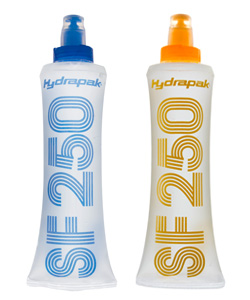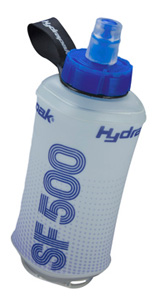 Hydrapak SoftFlask quick overview:
Hydrapak SoftFlask quick overview:
- Usual full price: $13.99 USD
- Weight: 24 g (250ml Energy Flask)
- Pros: Light, Versatile, No Waste, Ease of Use
- Cons: Durability, Hydration
- Suitability: Rando racing, ski touring, ultra running, scrambling, alpine climbing, trail running.
Bottom line:
Relatively cheap and an improvement over individual gel packages.
Product description and How we tested it:
Hydrapak is a relative newcomer to the hydration market and primarily a producer of standard plastic water bottles as well as Camelbak-style reservoirs. They also produce a slightly more niche product however, the soft flask. This is a collapsible soft plastic flask in various sizes with a small bite valve at the top. They come in two designs, one in more of a bottle shape ‘for hydration’ and one in a flask shape ‘for energy’. Both types have several size options.
I’ll admit to getting inspiration for this idea by seeing an athlete in one of the ISMF World Cup videos racing with a soft flask taped to their backpack but after a season of running and skiing with versions of these flasks, here are a few of my thoughts:
The 250ml ‘energy’ soft flasks are very useful for skimo races. Around the 2 hr time duration, these races require calorie intake but dealing with the hassle of several gel packets or chewing solid bars is not ideal with gloves and cold fingers. Additionally, cold temps make gels much harder to swallow. My solution has been mixing four gel packs (or using bulk gel from Hammer Nutrition) into a soft flask with water. You avoid any packaging issues and the now slurry like mixture is much easier to swallow. I tape it onto my shoulder strap for no-hand access when it is warm and keep it in my skin suit pocket when it’s cold.
 These flasks are also useful for similar length running races and fit well in a vest pocket or just as a handheld. Once you finish the flask, crumple it up and stick it in your shorts pocket.
These flasks are also useful for similar length running races and fit well in a vest pocket or just as a handheld. Once you finish the flask, crumple it up and stick it in your shorts pocket.
150ml soft flasks are less useful, but in a short race, where only one shot of gel slurry is needed, it is sufficient and ultra-light.
The 500ml ‘Hydration’ flask is more of a bottle type design. It has a different shape than the ‘nutrition’ flasks and fits well anywhere you would put a standard bottle (vest pockets). I use these to replace the bottles in my vest primarily because they are lighter. Slightly smaller than a standard bottle, they don’t hold as much fluid but are easier to carry as a handheld, even without a strap.
Pros:
- Eliminates individual gel packaging. No fumbling with package tops. All ready to go at your finger tips.
- Allows you to create a gel ‘slurry’ by adding water. Much more friendly for consumption during a race.
- Ease of access – tape it to the strap of your pack for hands-free, or stick it in a running vest pocket or even the pocket of your shorts!
- Easy to take apart the nozzle for cleaning out scuzzy old gel.
Cons / What can be improved about this product:
- These are not particularly durable – be careful with duct tape and scissors. Also will not cushion a fall very well if you land on it 🙂
- Some older/smaller models do not have a function to lock the flask shut. This means it could potentially leak in your bag if squeezed at the nozzle properly. I haven’t really had this happen and the nozzle is pretty well sealed. Not a big deal as long as you are careful
Product Specs (250ml Energy SoftFlask):
- Weight: 24 grams
- Materials: Silicone/TPU
- Size: 150ml and 250ml ‘For Energy’, and 350ml, 500ml, 750ml ‘For Hydration’
Online stores that carry Hydrapak SoftFlasks:
- $13.99 USD directly from Hydrapak
- $9.95 USD from Hammer Nutrition


Stano Faban says
Richard, I missed your comment and questions. My apologies.
There are insulation sleeves for bladder houses and work pretty well but at -10 C and skiing down… some times they freeze too.
I usually use just a cycling bottle (700ml) with a warm-ish water and carry it inside one of the outside pockets of my suit. So far never froze. And even if the “sucking thing” froze then I can still just get the lid off and drink that way.
The soft flask work great the same way like my cycling bottle but are better for storage once you are it’s empty.
Jonathan Shefftz says
Richard, a bladder with exposed hose would definitely be the most vulnerable.
I have one of these flasks, and although I haven’t used it yet in cold weather, if it were kept a pocket of a race suit or jacket, I’m very confident that body heat would prevent the valve from freezing even in extremely cold weather.
Richard Ferron says
I’m starting skimo racing this year and am wondering about race hydration solutions. Living in Quebec where it’s often below -10C a bladder is not really an option. Would a soft flask do well in the cold? Do you need an insulation pocket? Or like you said, is it best to carry it in your jacket? What are the typical solutions / options?
Thanks for the review!